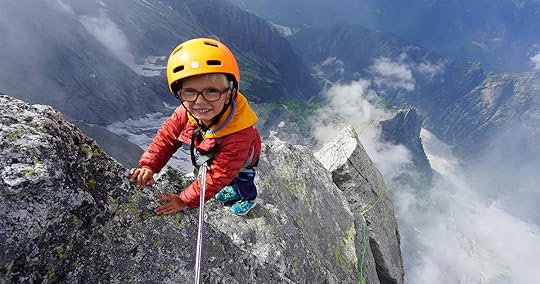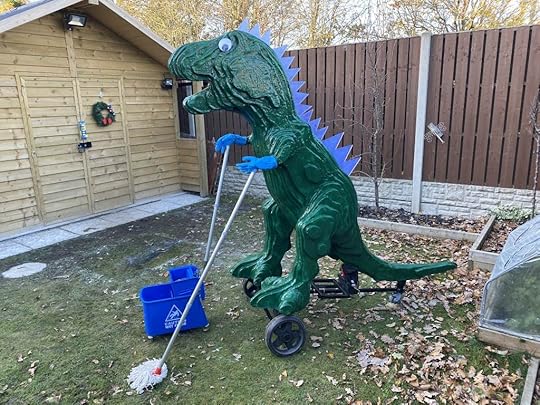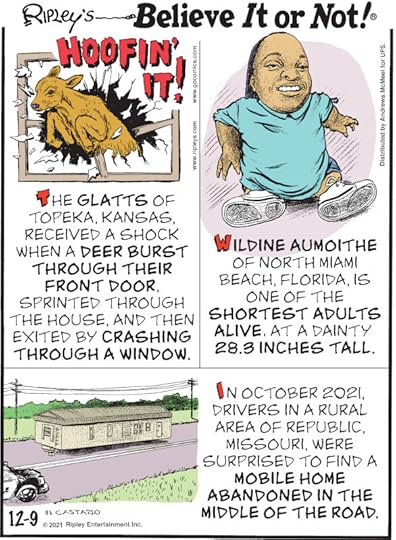Ripley Entertainment Inc.'s Blog, page 112
December 14, 2021
CARTOON 12-14-2021
December 13, 2021
Siblings Aged 3 and 7 Years Old Climb 11,000-Foot-Tall Mountain!
Featured in Ripley's Believe It or Not!

Professional explorer Leo Houlding is no stranger to climbing. He’s been doing it since he was 10 years old and has made many major expeditions across the globe including to the summit of Everest, remote Arctic and Antarctic peaks, Yosemite, and jungles of South America.
Leo recently introduced his wife and children to new heights, quite literally. There’s no denying this UK-based family felt on top of the world (pun intended) during one of their most recent excursions.

Photo courtesy of Leo Houlding
A Family That Climbs Together, Stays TogetherThis past year, Leo decided to celebrate his 40th birthday by showing his two children, Jackson and Freya, and wife Jessica, what he loves most: climbing cool mountains and exploring new lands. The family spent four days together scaling the north ridge of Piz Badile, part of the picturesque Alps on the border of Switzerland and Italy.
Despite being only three and seven years old at the time, respectively, Jackson and Freya, successfully climbed this nearly 11,000-foot-tall mountain. Freya became the youngest person to climb the Piz Badile unaided, and Jackson was the youngest person to ever make it to the top!

Photo courtesy of Leo Houlding
Freya made the trek on her own two feet, and Jackson was carried up most of the way in his mother’s backpack carrier. It took the family several days to complete the climb, and they spent the fourth night in a cliffside hut. There was a huge drop in the cliff just a few feet from the hut’s door (warning: don’t look down!). The other nights were spent in bivouacs shelters.

Photo courtesy of Leo Houlding
Young Jackson said he enjoyed the part of the climb he was able to accomplish on his own and Freya said it was both scary and fun, but she was very proud of herself! The children were spoiled with sweets at the end of their trip for their perseverance and unmatched determination.
They’re Moving MountainsThe family has previously climbed a few other mountains in the UK and Europe including Triglav in Slovenia, but the Piz Badile climb was mountains harder than the Triglav climb, according to Leo. Aside from going up the mountain, the family has had their fair share of expeditions going down the mountain as well.
In 2019, Leo, Jess, Freya, and Jackson (who were only six and three, respectively, at the time), skied down Les Grandes Platiers in Flaine unassisted and unsupported. Leo reported this was one of his family life goals. He can absolutely check that one off the bucket list!
One of the family’s latest excursions was to the mountains of Wyoming, where they spent two weeks in the wild camping, hiking, and — of course — climbing!
View this post on Instagram
A post shared by Leo Houlding (@leo_houlding)
These kids will undoubtedly always have a fun fact for future ice breakers. If you’re looking for some adventure inspiration or want to learn more about the Houlding family’s fun outdoor adventures, check out their feature in our latest annual book: Ripley’s Believe It or Not! Out of the Box!
Take Your Own Step Out of the Box!Challenge yourself to get a little weird, try new things, and step out of your comfort zone with inspiration from Ripley’s Believe It or Not! Out of the Box, available now on Amazon and at most major retailers.
By Sam McCormack, contributor for Ripleys.com
STEP OUTSIDE OF YOUR COMFORT ZONE Experience the stories of adventurers near and far, from a three-year-old mountain climber to hair-hangers and acrobats. Leave inspired by unbelievable talents, breathtaking bucket list-worthy locations, and curious discoveries, all from people just like you as you uncover the pages of Ripley’s newest annual book!Source: Siblings Aged 3 and 7 Years Old Climb 11,000-Foot-Tall Mountain!
CARTOON 12-13-2021
December 12, 2021
CARTOON 12-12-2021
December 11, 2021
CARTOON 12-11-2021
December 10, 2021
Thousands of Honeybees Rise from Volcano Ashes
Featured in Ripley's Believe It or Not!

About 50 days after a volcano eruption caused a buzz around the Canary Islands, thousands of honeybees emerged from the ashes, after having sealed themselves in their hives to weather the lava flow.
The Cumbre Vieja volcano violently erupted in September, firing off a wave of lava that destroyed homes, businesses, and churches around the resort island of La Palma, leaving little in its wake—except for some busy bees!
Embed from Getty Imageswindow.gie=window.gie||function(c){(gie.q=gie.q||[]).push(c)};gie(function(){gie.widgets.load({id:'Z-b8Xe6ORC9Wvvg-WQ19GA',sig:'Oo7Le2cUHFr6B-j7gVXzNZ7s-3Nd8dpFGsCP_CGLArI=',w:'594px',h:'395px',items:'1235795745',caption: false ,tld:'com',is360: false })});
Upon returning to his devastated village to check on his hives, one local beekeeper was shocked to find five hives filled with tens of thousands of bees buzzing about as if nothing had ever happened despite being completely covered in volcanic ash.
The island is home to about 80,000 residents—100 of them being beekeepers who spend their days managing hives. The work of these folks is extremely vital to the maintenance of the local ecosystem and also makes them key economic players for La Palma as they sell honey throughout the region. A life without their bees would only lead to more devastation, but thankfully these little guys are fighters.
By sealing themselves in the hives, these brilliant bees managed to survive the volcano’s extreme heat and deadly gases and avoided starving to death by feasting on the honey they’d stored for a rainy—or fiery—day.
As the volcano continues to spew lava, the bees’ survival offers a glimmer of hope for locals who depend on the millions of Canary black bees that call the island home for economic and ecological support.
To protect themselves from the noxious gases, the bees used propolis—a sort of bee glue collected from plants and buds—to seal themselves in while they hunkered down, leaving just one tiny pathway back into the world to use once it was safe. Honeybees commonly use propolis to plug any gaps in hives to protect them from rainwater.

The bees had some un-bee-lievable luck on their side and the volcanic ash that rained over their hives happened to be light and porous enough to allow oxygen to enter into the hive.
After spending almost two full months insulated in the hive, these bees proved yet again that despite the numerous threats bees face daily, these resilient creatures will continue to literally and figuratively rise from the ashes.
By Meghan Yani, contributor for Ripleys.com
EXPLORE THE ODD IN PERSON! Discover hundreds of strange and unusual artifacts and get hands-on with unbelievable interactives when you visit a Ripley’s Odditorium!CARTOON 12-10-2021
December 9, 2021
How The UAE Is Using Drones To Control The Weather
Featured in Ripley's Believe It or Not!

Humanity has reached a crucial point in the battle for the future of the planet. If temperatures continue to rise, both floods and droughts will leave populations in peril all over Earth. Areas subject to extreme temperatures will only get more hazardous, and one such area is the United Arab Emirates.
The UAE’s stifling mix of incredible desert heat and limited rainfall poses great danger. The good news is that the technological innovation and advancements the region is known for can also be utilized to help with this dilemma. The UAE reportedly sees no more than 4 inches of rain each year, almost exclusively in brief bursts during the winter months. Recently, the region has been developing an ingenious solution to limited rainfall: creating its own precipitation using drones!

To understand the incredible technology at work here, it’s important to understand the science of rainfall. Essentially, clouds are comprised of drops of water that are individually so small that they don’t weigh enough to fall from the sky. This only happens when they band together into larger drops. This reaction is rarer the higher the air temperature, so the problem faced by the UAE was how to precipitate the process (pun intended).
The objective of the drones, therefore, is to encourage this clumping together of water droplets. In July of 2021, tests took place to see if such an approach would be feasible. The concept is a logical one: drones would fly into clouds, at the behest of on-the-ground technicians, and then emit electrical pulses. This electrical energy, with any luck, would hasten the reaction of droplets within the clouds, potentially stimulating much-needed rain in the UAE!

The technique is combined with one known as cloud seeding, which has been used to both cause or prevent rain and snow alike. Cloud seeding is controversial, though, because it artificially adds elements to the atmosphere. In 2018, for instance, Idaho scientists flew planes into clouds, dispersed silver iodide, and succeeded in creating the first confirmed human-induced snowfall in history. The question, however, was whether this sort of technology was reliable enough and could be used on a large enough scale, to have the sort of impact needed to address the UAE’s lack of “natural” rainfall.
Resources are continually pumped into the project in efforts to find the answer to that question. The report from July of 2021 stated that, though things were starting small, a cool $15 million had been dedicated to what could prove to be the critical work of cloud seeding.
These are not the first examples of the UAE deploying such technology, nor are the drones the only strategy considered for going about it. Small airplanes have also been employed by the government, whenever likely-looking cloud formations have appeared.
Other Uses of Cloud SeedingFascinatingly, cloud seeding has been utilized in a variety of other ways besides. In the wake of the Chernobyl nuclear plant disaster of April 1986, Yuri Izrael, the USSR’s minister of hydrometeorology, found it was his only hope to divert radioactivity from reaching Moscow. As the hours following the disaster unfolded, it was tough to predict just how much damage would be done as the radiation spread. Izrael only knew that deadly clouds could have passed across Belarus towards the country’s capital.
Here, again, aircrafts armed with sodium iodide flew into the unmistakable radioactive black clouds, dispensing sprays of the chemical wherever they had a clear shot to do so. Reportedly, the method worked, and the radiation in the clouds fell with the rain.
Embed from Getty Imageswindow.gie=window.gie||function(c){(gie.q=gie.q||[]).push(c)};gie(function(){gie.widgets.load({id:'hcU0eou0SjBm4KNcpY_xUw',sig:'gEep7BILNtT9c-PVd5SqBdasyd4ijxu4oJCeUU-WB2A=',w:'594px',h:'372px',items:'491820792',caption: true ,tld:'com',is360: false })});
Tragically, less-populated regions in Belarus seemed to pay the price, as this atmospheric manipulation meant that this was where a lot of the toxic chemicals fell instead. The levels of radiation in the region were reportedly up to 30 times higher than they may have been without this endeavor taking place.
For better or for worse, cloud seeding has proven to be a technique that works. In a variety of situations, rain and snow alike have seemingly been produced where they otherwise would not have happened. As weather conditions continue to worsen and Earth’s climate becomes more and more unstable, this technology could prove vital to our very survival.
A Last-Ditch Hope?The rising overall temperature of the planet could prove catastrophic for a number of reasons. As reported by NASA, Earth’s water cycle — the natural process by which water is recycled through precipitation, evaporation, and condensation — is reliant on a delicate balance of several factors, the temperature being just one of these. If human activity, and the natural course of things, continues to throw this system out of balance, rainfall will be affected more and more across the planet.
Just as dangerous as a deficit of water, of course, is an excess of it. Extreme flooding is another potentially disastrous consequence of climate change, hand in hand with rising sea levels. It’s estimated that, at our current course, several big coastal cities such as Miami, Osaka, New York City, and Guangzhou may be completely flooded, with damages to such metropolitan powerhouses costing a potential $1 trillion each year!
Embed from Getty Imageswindow.gie=window.gie||function(c){(gie.q=gie.q||[]).push(c)};gie(function(){gie.widgets.load({id:'e8h6QoRRQ_ZfP-pZCW7g1Q',sig:'en-oaJh0k33FGVkh34EwCSuyJkwE7aJPQn9HSCcFj1Q=',w:'594px',h:'395px',items:'1228549934',caption: true ,tld:'com',is360: false })});
Weather drones and cloud seeding technology could help to alleviate these issues, but it’s crucial that humanity proceeds carefully. Exploitation of natural resources is a huge contributor to climate issues, but perhaps the manipulation of cloud power could just save us too.
By Chris Littlechild, contributor for Ripleys.com
EXPLORE THE ODD IN PERSON! Discover hundreds of strange and unusual artifacts and get hands-on with unbelievable interactives when you visit a Ripley’s Odditorium!CARTOON 12-09-2021
December 8, 2021
Watch Child-Inventors’ Kelsey And Lexi’s Floor-Mopping Dinosaur Come To Life!
Featured in Ripley's Believe It or Not!

The time has come, young inventors, to announce the winner of our Out of the Box Challenge with Kid’s Invent Stuff! We received so many captivating and dazzling invention ideas from young geniuses across the world. With everything from an ice cream-making hoover to a jelly shower and a ping pong trolley, there was no shortage of inventions to choose from.
For this particular build, we were on the hunt for a kooky, crazy, out-of-the-box idea to make life better, and sister duo, Kelsey (9) and Lexi (10) from the United Kingdom, certainly delivered. Say hello to their floor-mopping dinosaur!

This monstrosity comes equipped with a bucket and mop to lend a helping hand (claw?) in a sticky, dusty, or downright dirty situation. At its core, the dino is constructed of foam for a lightweight and efficient cleanup. Ruth and Shawn at Kids Invent Stuff drew up the plans for the 7-foot T-rex on computer software and sent it off to a friend to create the building materials. The dino’s foam pieces were cut and sliced to precision, but it was up to the crew to bring him to life.
Ruth and Shawn assembled every piece of the dino puzzle, covered him in resin for a strong and sturdy exterior, painted from head to tail, and, of course, popped on his light-up blue spikes and googly eyes!

Through projects like our Out of the Box Invention Challenge, Kids Invent Stuff encourages youth to think creatively and explore STEAM learning with their very own ideas. If it can be drawn, dreamt, or doodled, it can be done – just like Lexi and Kelsey’s dino who “will pursue and destroy all the tricks germs deploy!”
Find more incredible inventions and kooky contraptions inside the pages of our newest book, Out of the Box!
STEP OUTSIDE OF YOUR COMFORT ZONE Experience the stories of adventurers near and far, from a three-year-old mountain climber to hair-hangers and acrobats. Leave inspired by unbelievable talents, breathtaking bucket list-worthy locations, and curious discoveries, all from people just like you as you uncover the pages of Ripley’s newest annual book!Source: Watch Child-Inventors’ Kelsey And Lexi’s Floor-Mopping Dinosaur Come To Life!
Ripley Entertainment Inc.'s Blog
- Ripley Entertainment Inc.'s profile
- 52 followers









